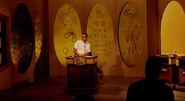| Aired | |
| NBC daytime, January 3, 1966 - September 26, 1969 | |
| Run time | |
| 30 Minutes | |
| Host | |
| Bill Cullen | |
| Announcer | |
| Jack Clark, Don Pardo | |
| Origination | |
| NBC Studio 6A, New York City, New York | |
Game Format
Two contestants faced a nine-space game board, divided into three rows of three boxes. The outer boxes were numbered 1–8, and the center box contained the "Eye Guess" logo. At the beginning of the game, the answers hidden behind the outer boxes were revealed for six to nine seconds and then re-covered. Questions were asked by the host, and contestants were required to provide only the number behind which the answer was hidden. Points were awarded for a correct answer, and the contestant who responded correctly was asked a bonus question for additional points. If the bonus question was missed, that contestant's turn ended and the opponent was asked the next question.
A contestant could call for the "Eye Guess" space if they thought that the correct answer was not among the eight choices revealed at the start of the game. In such instances, the answer would be revealed only if it was correct for that question. Otherwise, a blank card would be revealed.
Questions in each round covered a wide range of topics and were assembled in such a way that choosing an incorrect number for a question could yield humorous results, which was the main appeal of this otherwise simple game.
Each game consisted of two rounds, with correct answers worth 10 points on the first round and 20 on the second. Although there were nine different answers per round, each round only featured eight questions, meaning one of the nine answers was not used (and never placed behind the "Eye Guess" space). A contestant who provided five consecutive correct answers won a bonus prize, usually a trip. Toward the end of the show's run, contestants who both missed four consecutive questions in the main game each received a series of at-home memory-improvement books.
The first contestant to reach 100 points won the game and earned the right to play a bonus round. Later, the producers changed the rules, awarding a prize for each correct answer, with seven as the winning score.
Frequently a game could not be completed within the allotted time. In such instances, an audible signal would sound and play was suspended at that point. If it happened during the course of a game, play would resume the following day with the same questions and answers, but the answers were placed behind different numbers on the board. If time was called during the bonus round, play resumed from that same point the following day, with the board in the same position; i. e., with the same prize cards revealed in the same locations as before.
There were no returning champions. Each game featured two new contestants.
Bonus round
The first bonus round was played from January 3–14, 1966. The contestant was shown eight pairs of celebrities (a man and woman). Cullen would read a name, and the contestant would be required to locate that celebrity's spouse on the board. Each correct answer awarded the contestant $25, and a new car was awarded if the board was cleared.
The second bonus round was used from January 17, 1966 to August 30, 1968. Behind seven of the numbers on the board were various prizes; behind the remaining number, a "Stop!" card. The contestant continued to call numbers and win prizes until finding the "Stop!" card. If the contestant revealed all seven prizes, the contestant won a new car, ostensibly hidden behind the "Eye Guess" logo. The contestant kept any prizes revealed prior to the end of the round. If the "Stop!" card was revealed on the first selection, the contestant was allowed to choose another number as a consolation prize.
This bonus round was featured in all four editions of the show's home game.
Initially, prizes consisted of cash up to $100 or merchandise. By November 8, 1967, all prizes became merchandise. At some point after November 8, 1967, a new prize called "Jack's Pot" (named after announcer Jack Clark) was introduced, consisting of a cash prize that was awarded only if it was revealed on the first selection. If this did not happen, its location was revealed right away. The value started at $100 and increased by $100 each day until won.
The third bonus round was used for the entire final year of the show's run, from September 2, 1968 to September 26, 1969. Hidden behind spaces 1–3 and 6–8 were five "Go" cards and one "Stop!" sign (spaces 4 and 5 were not used in this format). Prizes of increasing value were awarded after each "Go" card was found. The contestant could stop at any point but lost all the prizes accumulated if the "Stop!" card was revealed. If all five "Go" cards were revealed without finding the "Stop!" card, the contestant won a new car.
Episode status
Virtually all of the series is believed to be destroyed due to network practices of the era, with the videotapes wiped and re-used.
One episode distributed for broadcast on November 8, 1967, in color, and the first half of a 1968 episode (before the "Stop and Go" bonus format), in monochrome kinescope, exist in the hands of collectors. Game Show Network has aired the color episode.
| This page uses Creative Commons Licensed content from Wikipedia (view authors). |
Trivia
Merchandise
Milton Bradley has released four editions of the game since 1966, all of which feature host Bill Cullen on the cover of the box.
Photos
Ticket
Episode Status
Video

Eye Guess- 1968 Episode (Part 1)

Eye Guess- 1968 Episode (Part 2)

Eye Guess- 1968 Episode (Part 3)

Eye Guess (1968)

Eye Guess
















